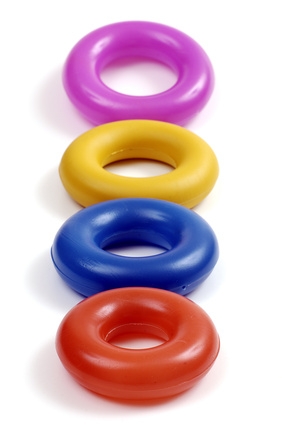
Fuel injectors are connected to a pressurized fuel line. The injectors on the Ford V-8 5.4 liter engine are positioned beside each of the eight spark plugs. The 5.4 liter engine has a metal fuel rail which is bolted to the engine to reduce vibration. Each fuel injector is connected to the fuel rail and engine with O-rings. The fuel injector's moving parts will eventually wear out regardless of how clean the injectors are kept. Replacement of failed or poorly performing injectors will result in an increase in power and fuel economy.
Depressurize the fuel line. Open the passenger side kick plate in the cab to expose the fuel safety cut-off switch. Unplug the switch to turn off the fuel pump. Attempt to start the engine several times to reduce the fuel pressure in the lines. Disconnect the vehicle's battery.
Disconnect the vacuum hoses and electronics connected to the air intake tube. Disconnect the air intake tube from the throttle body and air filter box and set aside. Remove any vacuum lines or devices restricting access to the fuel rails.
Unplug the electronics from each fuel injector. The fuel injectors will be connected to the chrome fuel rail. Remove the two bolts securing the fuel rail to the engine.
Lift the fuel rail from the fuel injectors. Rock the fuel rail side to side to disengage the fuel rail from each injector head. Because the fuel rail is rigid, the four injectors connected to the fuel rail must be disconnected for full access to the fuel injector. Fuel will spill from the fuel rail nozzles. Wipe away any fuel, or allow the fuel to evaporate before continuing.
Inspect the fuel injector heads for the O-ring. If an O-ring is not present on the fuel injector, look inside the fuel rail and remove the O-ring. Remove the singe retaining bolt holding the injector in place. Move the bolts away from the engine so they do not fall into the engine during the servicing process.
Grasp each injector with your hands and pull upward to dislodge the injector from the engine. If the injector resists strong pulling, rock the injector back and forth until the injector pulls free. Do not use pliers to remove the injectors if you intend to use the same injectors, as damage may occur. Account for all O-rings -- two per injector -- before continuing.
Install new O-rings on all the injectors. New injectors usually come with O-rings pre-installed. Lubricate each O-ring with motor oil before the fuel injector is installed in the engine. Apply the motor oil to the O-ring with your finger.
Place each fuel injector, nozzle first, into the injector hole. Align the retaining bolt hole with the hole on the engine. Press the injector downward to allow the O-ring to be seated in the engine. You may feel a slight popping sensation as the O-rings are seated. A properly seated injector will resist upward pulling. Insert and tighten the retaining bolt for each injector.
Connect the fuel rails to the injectors. Align each fuel injector head with the fuel rail connection. The fuel rail will have more room at the front of the engine than at the back; work from the back of the engine forward during the alignment to ensure each injector head does not become dislodged from the fuel rail. Press downward on the fuel rail over each injector, working from back to front, until all injectors are properly seated. As with the engine, a properly seated injector will resist disconnection.
Connect the fuel injector electronics plug.
Install all vacuum lines, components removed, air intake and electronics in the original position. Attach the vehicle's battery. Reconnect the fuel safety cut-off switch inside the passenger kick plate of the vehicle's cab.
Turn the ignition key to the "electronics only" mode. Wait 10 seconds for the fuel lines to pressurize. Turn the key off and repeat. Inspect the fuel rails for leaks. Start the engine to check installation.